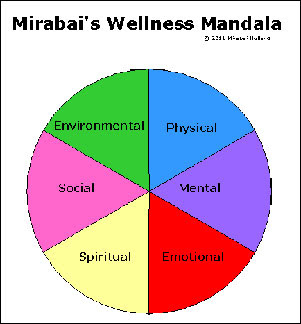 Wellness: Life is a balancing act.
Wellness: Life is a balancing act.
So I started thinking about wellness. What is wellness anyway?
It’s the absence of disease. If you are not sick you are well.
But it’s more than that isn’t it? It’s quality of life and for some it’s a balancing act; the balance of all things. I like this balance concept so I dug out one of my favorite balancing act tools:
Wellness Balancing Act Tool
The Mandala: the wheel of life. I wrote down all the types of wellness I could think of and ended up with 6 categories that I stuck on my Mandala to enable us to live well.
Here they are:
Physical Wellness
· Taking care of your body, eat right, exercise
· Visit your doctor regularly
Mental Wellness
· Keeping an open mind and trying to see other’s point of view
· Allowing your curiosity to take you to new places and learn new things.
Emotional Wellness
· Trying to keep a positive state of mind
· Cultivating self esteem
· Reaching out to others for support
Spiritual Wellness
· Recognizing your beliefs.
· Allowing your core values to direct your actions.
Social Wellness
· Developing positive inter-personal relationships at home and work
· Allowing yourself to give and receive love: to and from everyone that means that much to you including animals
· Participate in social situations; try not to stay on the sidelines.
Environmental Wellness
· Making your home environment peaceful, pleasant, safe and comfortable.
· Choosing an occupation and a workplace that doesn’t drive you nuts.
· Try to have a positive impact on our natural environment.
Recycle more, pollute less.
When the wheel is in balance it spins evenly. When even one of these categories is out of whack, the whole wheel starts to wobble.
So as a certified health coach I respectfully suggest you get rolling, get your balancing act together so you can live well.
Visit: www.mirabaiholland.com
Follow Mirabai Holland on














